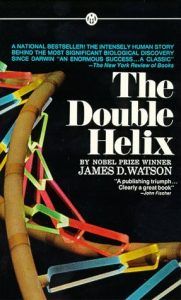
THE DOUBLE HELIX Shows Why #MeToo Was Always Necessary
Although I was always better at English than science in school, at the beginning of high school, I was obsessed with genetics. After I wrote an unpublishable novel about human cloning, I read The Double Helix, James Watson’s memoir of working with Francis Crick to discover the molecular structure of DNA. The book contains a lot of scientific jargon but can also be conversational, describing scientists’ rivalries in a gossipy tone. Ironically, Watson’s opinions of his coworkers often reveal more about him than about them.
 When Watson and Crick started researching genes at Cambridge University in 1951, most people didn’t know that DNA carries hereditary information. Some researchers thought proteins transmitted genetic information—not DNA, an acid. Watson got most of his knowledge about DNA from attending lectures by Rosalind Franklin, an X-ray crystallographer. Seeing one of Franklin’s images of DNA made the double helix structure clear to him: “The instant I saw the picture my mouth fell open and my pulse began to race (181).”
When Watson and Crick started researching genes at Cambridge University in 1951, most people didn’t know that DNA carries hereditary information. Some researchers thought proteins transmitted genetic information—not DNA, an acid. Watson got most of his knowledge about DNA from attending lectures by Rosalind Franklin, an X-ray crystallographer. Seeing one of Franklin’s images of DNA made the double helix structure clear to him: “The instant I saw the picture my mouth fell open and my pulse began to race (181).”
Watson and Crick used Franklin’s image (without crediting her) to make their model of the DNA molecule. Although Franklin’s work was instrumental to theirs, three of her male colleagues (Crick, Watson, and Maurice Wilkins) shared a Nobel Prize in 1962. Franklin’s work was largely ignored until after her death, and Nobel prizes are not awarded posthumously.
Watson’s infamous portrayal of Rosalind Franklin is openly misogynistic. Patronizingly referring to her as “Rosy,” he mocks her appearance and makes assumptions about her personal life:
By choice she did not emphasize her feminine qualities. Though her features were strong, she was not unattractive and might have been quite stunning had she taken even a mild interest in clothes. This she did not. There was never lipstick to contrast with her straight black hair, while at the age of thirty-one her dresses showed all the imagination of English bluestocking adolescents. So it was quite easy to imagine her the product of an unsatisfied mother who unduly stressed the desirability of professional careers that it could save bright girls from marriages to dull men. But this was not the case. Her dedicated, austere life could not be thus explained: she was the daughter of a solidly comfortable, erudite banking family. (10)
When I first read this passage at 15, I was appalled but dismissed Watson’s sexism as an outdated attitude. Rereading it as an adult, it’s apparent that sexual harassment and gender discrimination are systemic problems that still derail promising careers today. It’s also easy to see the connection between Watson’s contemptuous treatment of Franklin in person and the erasure of her professional contributions.
Tragically, Franklin died in 1958 at age 37 (from ovarian cancer, possibly caused by handling radioactive materials), without much acknowledgement for her work. Although she published many scientific papers, she never published a memoir. Watson’s memoir was published in 2001, more than 40 years after Franklin’s death. It’s a relief to see that many recent books celebrate Franklin, such as Rosalind Franklin: The Dark Lady of DNA and Rosalind Franklin and DNA. Picture and middle grade books also introduce her accomplishments to children.
Hopefully, the recognition that Franklin received after her death helps to correct the way that she was overlooked during her lifetime. When I first read The Double Helix, I noticed Watson’s personal bias but saw him as a product of his time. As an adult in the era of #MeToo and #TimesUp, which are long overdue, I can put his attitude in perspective. The Double Helix is still fascinating, despite its flaws. Unintentionally, it led me to ask how many other careers have been marginalized by workplace harassment.












